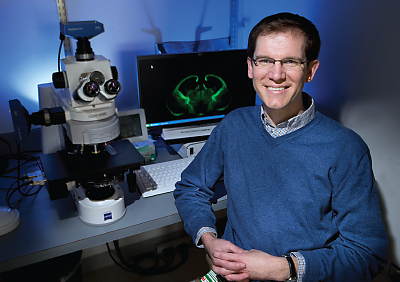Pieces of Autism Puzzle Slowly Coming Together
Abstract
Research into autism is advancing slowly but steadily on several fronts, even as patients and their families await signs of progress on treating the illness.
Autism was first described and named by Leo Kanner, M.D., in a classic 1943 paper, but most research into the condition has occurred only since 1980.
Yet three decades of investigation have only just begun to reveal an understanding of the disorder’s origins and possible treatments, said Jeremy Veenstra-VanderWeele, M.D., an assistant professor of psychiatry, pediatrics, and pharmacology at Vanderbilt University.

Medications may someday be available that improve autistic children’s ability to learn, but until then clinicians need to integrate interventions from several disciplines, according to autism specialist Jeremy Veenstra-VanderWeele, M.D.
Several obstacles have frustrated progress in research, said Veenstra-VanderWeele in a recent interview with Psychiatric News on the Vanderbilt campus.
Too often, intervention studies have used small sample sizes or failed to include control groups, he said. Outcome measures are hindered by difficulties in self-reporting from patients, so parent or teacher reports must serve as substitutes.
Medications used to treat autism are not specific to the disorder, he said. “In schizophrenia, you have antipsychotics, but for autism, there’s no ‘anti-autistic.’ ” In contrast, some behavioral treatments, especially early intensive behavioral intervention, based on the work of B.F. Skinner and others, do show promise.
“This nonspecific treatment has the best evidence for working and the biggest potential benefit for treating autism—at the moment,” he said. The caveat comes because information is accumulating steadily on risk factors for autism spectrum disorder, any of which might someday open channels for treatment. For example, an increasing number of genes have been shown to influence autistic phenotypes, although so far any single gene contributes barely 1 percent to 2 percent of the risk.
“The good news is that we can take these risk factors into mice, rats, and zebra fish and see what they do in the brain,” he said.
Signaling Pathways Provide Clue
Studies of Fragile X by Veenstra-VanderWeele and others point to particular signaling pathways (metabotropic glutamate-5 receptors) that appear to change in individuals with autism. They are now testing medications that “tune down” responsivity in the pathway.
Other pathways like GABA-B agonists have been tested as well, but conclusions have been hampered by outcome measures that show positive effects on the global impression of severity but not on individual measures of symptoms.
In another line of attack, a National Institutes of Health study of intranasal oxytocin found better emotional communication and attention to social cues in autism subjects. Those effects will now be tested by researchers at the University of North Carolina, Harvard, Vanderbilt, and Mount Sinai School of Medicine to see if improvements in social functioning can be replicated in real-world settings, he said.
Internet Touts Unproven Treatments
Complicating matters for both researchers and clinicians is the availability of multiple unproven “treatments” promoted over the Internet.
“With autism, it’s particularly striking that there are many proposed treatments in use, but there’s so little data,” he said. “Thousands of children are taking intranasal oxytocin or SSRIs or were given hyperbaric oxygen or chelation therapy without any data on how well they worked.”
A further check on initially positive interventions comes by tapering patients off medications to see whether the benefit is specific, he explained. “That’s rarely done with freelance treatments.”
The changes to the definition of autism in DSM-5 will require adjustments for researchers, Veenstra-VanderWeele noted. Diagnoses formerly joined are now separated, changing how populations are defined. “DSM-5 eliminates language that was confounding, instead of lumping groups that were different,” he said.
Ongoing studies can still use DSM-IV criteria to study the now-eliminated Asperger’s syndrome, he said, although new studies will use DSM-5, especially as they relate to verbal impairment and cognitive function.
In the clinic, though, DSM-5 won’t make a lot of difference in how the disorder is diagnosed, he pointed out. Adjustments in diagnostic terminology can help patients retain access to care. A former Asperger’s patient can now be described as having autism with a high IQ and good verbal ability and thus be able to access services that he or she might not have previously.
As for the future, a better understanding of the social brain may lead to better medications that work in conjunction with other therapies, said Veenstra-VanderWeele. Drugs—such as atypical antipsychotics, SSRIs, or oxytocin—that tackle individual symptoms may each help some subset of patients, but are not transformative.
“Every time I go to the clinic, I struggle when I have to tell families that we may not have anything that will actually help their children, but we can still support them as we try what we know,” he said.
Treating autism will mean integrating many disciplines, said Veenstra-VanderWeele. “As we gain a better understanding of the biology of autism, we shouldn’t discard teaching and psychology,” he said. “Medications may emerge that put the brain in a better place to learn, but we still need treatments that work together.”
Finally, researchers, clinicians, and families can learn something from children with autism.
“There are some children with autism who society says are extremely impaired, but who are reasonably happy,” he said. “Maybe we can help them construct a good, reasonable life within the context of their capacities, so they can have a meaningful job and experiences in life that are joyful, and we should be pleased by that success.” ■
Information about the Vanderbilt Kennedy Center’s Treatment and Research Institute for Autism Spectrum Disorders is posted at http://kc.vanderbilt.edu/triad/.



